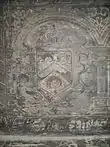Edward Nicholas Kendall
Edward Nicholas Kendall, né le à Pelyn (près de Lostwithiel) et mort le à Southampton[1], est un hydrographe et navigateur britannique.
| Naissance | Pelyn (d) |
|---|---|
| Décès |
(à 44 ans) Southampton |
| Nationalité | |
| Activités |
Explorateur, officier de marine |
| Père |
Edward Kendall (d) |
| Mère |
Mary Champion Hicks (d) |
| Fratrie | |
| Conjoint |
Mary Anne Kay (d) (à partir de ) |
| Enfants |
| Arme |
Royal Navy (à partir de ) |
|---|---|
| Grade militaire |
Lieutenant (à partir de ) |

Kendall est le premier Européen à apercevoir Wollaston Land[2].
Biographie
Entré dans la Royal Navy le 26 octobre 1814[3] après des études à la Royal Naval Academy, il sert à Sal (Cap-Vert) (1819)[4].
Avec George Francis Lyon sur le Griper, en 1824, il traverse la péninsule de Melville en Arctique[5] puis, l'année suivante, est engagé par John Franklin comme midshipman lors d'une expédition avec John Richardson et George Back à l'est de la rivière Coppermine. Durant cette expédition, il est le premier à voir le Wollaston Land[6].
Promu lieutenant en 1827, recommandé par la Royal Geographical Society, il devient second de Henry Foster sur le Chanticleer et explore avec lui les Shetland du Sud où il débarque en 1829. Il y étudie le magnétisme et analyse la gravité autour du volcan Deception. Il publie dès 1831 ses premières cartes des Shetland du Sud et de l'archipel Palmer.
Démissionnant de la marine en 1838, il devient gestionnaire de l'immigration en Australie. En 1845, il est nommé superintendant de la Peninsula and Oriental Steam Company.
Publication
- 1842 : Remarks on steam communication between England and Australasia: As combined with a system of weekly communication between the colonies of Australasia
Hommages
Il est mentionné par Jules Verne au sujet de ses voyages dans les mers polaires dans son roman Le Sphinx des glaces (partie 1, chapitre III)[7].
Kendall Island (en) dans le delta du Mackenzie[8], le cap Kendall (rivière Coppermine)[9] et Kendall Rocks (en) dans l'archipel Palmer, ont été nommés en son honneur[10].
Notes et références
- Melville Henry Massue marquis de Ruvigny et Raineval, The Plantagenet Roll of the Blood Royal, 1994, p. 51
- Llewellyn Styles Dawson, Memoirs of hydrography: including brief biographies of the principal officers who have served in H.M. Naval Surveying Service between the years 1750 and 1885, H.W. Keay, (lire en ligne), p. 105
- Francess G. Halpenny, Dictionary of Canadian Biography,volume 7, 1988, p. 463
- « Kendall, Edward Nicholas », Dictionary of Canadian Biography (consulté le )
- The Civil engineer and architect's journal,vol. 9, William Laxton, 1846, p. 57.
- Llewellyn Styles Dawson, Memoirs of hydrography: including brief biographies of the principal officers who have served in H.M. Naval Surveying Service between the years 1750 and 1885, H.W. Keay, 1830, p. 105
- Alexandre Tarrieu, Dictionnaire des personnes citées par Jules Verne, vol. 2 : F-M, éditions Paganel, 2021, p. 183-184
- Sir John Franklin et Sir John Richardson, Narrative of a second expedition to the shores of the polar seas, in the years 1825,1826, and 1827, Carey, Lea and Carey, (lire en ligne), p. 49
- Sir John Franklin et Sir John Richardson, Narrative of a second expedition to the shores of the polar seas, in the years 1825,1826, and 1827, Carey, Lea and Carey, (lire en ligne), p. 215
- « Kendall Rocks Gazetteer of the British Antarctic Territory Id 109598 », Australian Antarctic Data Centre (consulté le )
Liens externes
- Ressource relative aux beaux-arts :
- Notice dans un dictionnaire ou une encyclopédie généraliste :